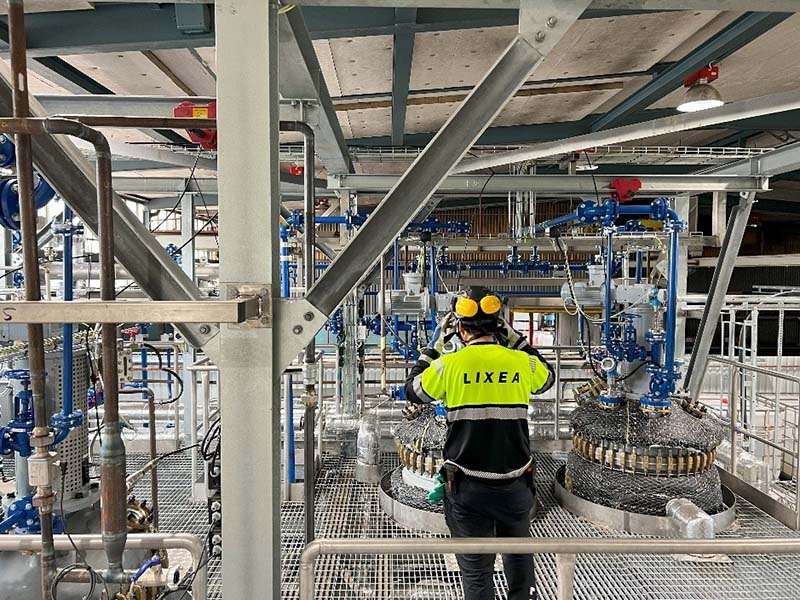Professor Jason Hallett, co-founder of university spinout Lixea, explains how the how the company discovered a route turning wood and agricultural waste into sustainable materials and fuels.
The greener future
Was it a childhood growing up in rural surroundings of the US state of Maine, that led Professor Jason Hallett on the path to co-founding a company that has developed a process using ionic liquids to produce base chemicals from biomass sources like wood and agricultural waste? It's a question he ponders on occasion.
“It is somewhat funny that I have gone full circle. From growing up surrounded by forests, and now we are working with wood pulp,” says Hallett, who took a journey via a very good grasp of mathematics and two chemical engineering degrees in the US, to come to the UK in 2006 to do postdoctoral research on ionic liquids.
Hallett, along with his colleagues Dr Agi Brandt-Talbot and Dr Florence Gschwend, are the founders of Lixea, a company started in 2017, which grew out of doctoral research carried out by Brandt-Talbot while Hallett was conducting postdoctoral research at the UK’s Imperial College.
The company's technology converts wood waste or agricultural residue into high-quality intermediates for sustainable chemicals, materials and fuels using solvents called ionic liquids, with the aim of providing more sustainable alternatives materials for industry.
Lixea says its proprietary ionic liquid is thermally stable and simply synthesised from readily available chemicals, which eliminates the traditionally prohibitive high production costs. This means it can break down woody biomass into its constituents cellulose, lignin and small molecules in an environmentally friendly and low-cost way.
Lixea's co-founders: Dr Agi Brandt-Talbot, Professor Jason Hallett, and Dr Florence Gschwend (Image courtesy of Lixea)
Brandt-Talbot and Hallett collaborated on research around the use of biomass and its potential as a renewable feedstock. The research produced a discovery which the collaborators believed could have a positive impact on the use of biomass in moving to a more sustainable economy.
The researchers thought that the discovery had commercial viability says Hallett, but after a couple of years of trying to move the discovery along Brandt-Talbotmoved on to another chemical start-up.
However, with Hallett continuing his work at Imperial and in time becoming the recipient of several grants around biorefining, he was able to get Brandt-Talbot to return to Imperial as a postdoc and have a another go at commercialising the initial discovery.
Ionic liquids
So, what was it that Brandt-Talbot and Hallett were hoping to commercialise? As Hallett explains, Brandt-Talbot’s discovery, as with many of the best, was something of an accident. “Agi was looking at ways to dissolve woodchip using ionic liquids,” explains Hallett.
Ionic liquids are a class of compounds that have application in several areas. As a solvent they have the advantage of being more environmentally friendly than traditional volatile organic solvents used in many industrial applications. However, in some cases ionic liquids can be complex and very expensive, making them not so attractive for large scale use.
While working out which ionic liquids would be the most useful for dissolving biomass, Brandt-Talbot and Hallett noticed that during one experiment only half the woodchip placed in the solvent was dissolving.
Fortunately, Brandt-Talbot decided to work out what had caused the phenomenon rather than discard the experiment, and realised that the ionic liquid used had become wet, due to the wood sample that was introduced to the liquid not being properly dried.
Hallett explains that it had been understood that ionic liquids work best with dry materials, but the experiment had allowed the waste biomass to be separated out into a part that was soluble in the ionic liquid, and a solid material that could easily be recovered. This is the basis of Lixea’s Dendronic Process which is finding application in areas such as the disposal of treated wood.
A solution to a problem
“Wood is really a big problem in disposal,’ says Hallett. This is where the research being carried out by Gschwend comes in. Hallett explains that Gschwend was looking at the issues related to disposing of treated wood. “A lot of wood waste we can incinerate for power, but there is an exception where the wood might be used, for example, in construction and is treated with preservatives such as chromated copper arsenic, which protects the wood from insects and decay.”
When buildings that contain this wood come to the end of their life or are refurbished, disposing of this treated material is a problem.
“Disposing of this wood requires specialised incinerators, or sending it to landfill, neither is ideal,” Hallett says. But Lixea’s Dendronic process allows the cellulosic material to be separated out from the copper and arsenic, with the latter two components being recovered safely and the cellulose then becoming available for use in other ways.
And, as Hallett explains, Lixea’s Dendronic Process will work with just about any biomass feedstock. “The reason it works with virtually any feedstock is that it’s an extremely aggressive deconstruction matrix, so it will take apart composites well. It will dissolve everything that’s not cellulose.”
The process also leads to the production of renewable materials that can be used as feedstock in routes where traditionally petroleum-based materials might be used. Lixea has said that its aim is to offer industry a clean and sustainable alternative to traditional feedstocks.
Timing is everything
Refining the Dendronic process now means that Lixea not only has a route for producing base chemicals from biomass, which can be used in a range of production processes, but also a pilot plant, located in Sweden, which came on stream during 2024. But getting to that point has not been without its challenges.
Lixea's pilot scale facility in Sweden (Image courtesy of Lixea)
“We had done much of the work to get Lixea to an investable place off of the incredible ability of Florence to win prize money,” Hallett says. There was also a fair amount of goodwill with Imperial allowing the fledgling business to use its laboratories as the project moved into the scale-up phase.
“With our grants we needed match funding, and we had been able to attract investment to support this. As we were drawing to the end 2019, around mid-December, we had an investment round set up. We were set to have the final pitch meeting to get things ready for February 2020. The lead investor asked to postpone our meeting until March 2020, because all a sudden a virus meant that people were required to work remotely, the meeting and the funding round were cancelled because of the pandemic,” Hallett recalls.
“Suddenly we had lost our investors, this was a huge blow, a massive hurdle that was suddenly put in our way. But we were far too committed by this point to halt the project,” says Hallett. “I think that it was probably the only time in the history of Lixea where things seemed hopeless. Losing the investors was the only time where it sort of looked like there was no way out.” Hallett says.
Next steps
Developing a plan to overcome this impasse, Lixea decided to take on new expertise, one of those experts being business development director, Krisztina Kovacs-Schreiner, who is now Lixea’s CEO. With the strengthened team and a fresh focus, Lixea was able to get financial support and start work on the construction of it pilot-scale plant in Sweden. This facility has been used to refine the technology and test the production processes with customers and industry partners. The positive results from this facility now means that the company is in the process of building a commercial demonstrator facility which will be capable of processing 25 000 tpa of biomass.
Thinking about what the next stage might be, there is potential for Lixea to licence out the technology as well as using is to produce cellulose fibres, a more challenging production process. With increasing focus on sustainability and renewables, the outlook for Lixea is positive.
But Hallett and the team are mindful of the external factors that can pose challenges to Lixea’s growth. “The fluctuating price of oil has the potential to make it much cheaper use petroleum-based materials as a feedstock,” Hallett notes. But with a sustainable and abundant biomass feedstock and a growing desire for sustainable production, it could be argued that Lixea’s technology is coming of age at the right time.


